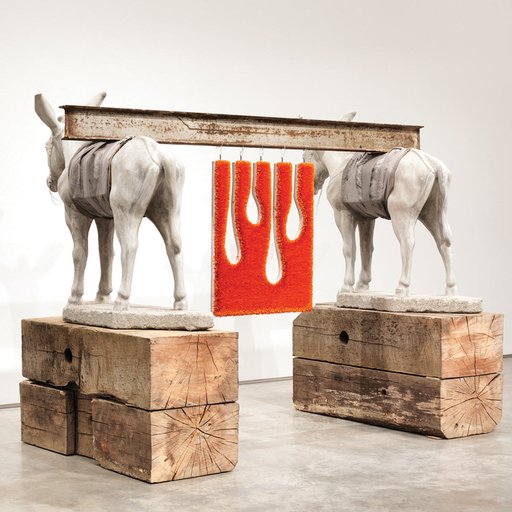Adriana Varejão
With a diverse practice comprising painting, sculpture, drawing, installation and photography, Adriana Varejão is one of the most original voices in contemporary Brazilian art. Her work address themes of colonialism, miscegenation and anthropology in Brazil, one of the most ethnically diverse countries in the world. Infused with layers of meaning, her work contains references to both her personal and Brazilian history. Her varied sources of inspiration range from art history to religious art, from erotic art to decorative art, from wall tiles to ceramics, from colonial iconography to images produced by European travellers, and from natural sciences to cartography. She researches these disparate histories and weaves various elements, from traditional to marginalia, together to evoke often forgotten stories and references.
Speaking about her work, the artist says: "My fiction does not belong to any time or place, instead it is characterised by themes dealing with rupture and discontinuity. Everything is contaminated. In my work, the formation of Brazilian culture from the colonial period onwards is used as a metaphor for the modern world."
A major retrospective of her work, Histórias às margens (Histories at the margins), was displayed at the Museu de Arte Moderna de São Paulo, São Paulo …
With a diverse practice comprising painting, sculpture, drawing, installation and photography, Adriana Varejão is one of the most original voices in contemporary Brazilian art. Her work address themes of colonialism, miscegenation and anthropology in Brazil, one of the most ethnically diverse countries in the world. Infused with layers of meaning, her work contains references to both her personal and Brazilian history. Her varied sources of inspiration range from art history to religious art, from erotic art to decorative art, from wall tiles to ceramics, from colonial iconography to images produced by European travellers, and from natural sciences to cartography. She researches these disparate histories and weaves various elements, from traditional to marginalia, together to evoke often forgotten stories and references.
Speaking about her work, the artist says: "My fiction does not belong to any time or place, instead it is characterised by themes dealing with rupture and discontinuity. Everything is contaminated. In my work, the formation of Brazilian culture from the colonial period onwards is used as a metaphor for the modern world."
A major retrospective of her work, Histórias às margens (Histories at the margins), was displayed at the Museu de Arte Moderna de São Paulo, São Paulo in 2012, traveling subsequently to Museu de Arte Moderna, Rio de Janeiro, and MALBA - Museo de Arte Latinoamericano de Buenos Aires. She has held solo exhibitions at Dallas Contemporary, Texas; The Institute of Contemporary Art, Boston, USA; Hara Museum, Tokyo; Fondation Cartier Pour L'Art Contemporain, Paris; Centro Cultural de Belém, Lisbon; Domus Artium, Salamanca; Centro Cultural Banco do Brasil, Rio de Janeiro; and Bildmuseet, Umeå, Sweden. The artist's work has been widely exhibited within large-scale group exhibitions in various institutions.
A permanent pavilion devoted to Adriana Varejaõ's work opened in 2008 at Instituto Inhotim in Brazil.
Courtesy of Victoria Miro
Arizona State University, Phoenix, AZ
Bouwsfonds Kunststchting, Hoevelaken, Netherlands
Coleção Berardo, Museu de Arte Moderna de Sintra, Portugal
Coleção Patricia Phelps de Cisneros, Caracas, Venezuela
Ellipse Foundation – Contemporary Art Collection, Lisboa, Portugal
Foundation Cartier pour l’art Contemporain, Paris, France
Fundação Serralves, Porto, Portugal
Fundació “la Caixa”, Barcelona, Spain
Hara Museum of Contemporary Art, Tokyo, Japan
Inhotim Centro de Arte Contemporânea, Minas Gerais, Brasil
Museu de Arte Moderna de São Paulo, Brazil
Museu de Arte Moderna do Rio de Janeiro, Brazil
SMAK –Museum of Contemporary Art, Ghent, Belgium
Stedelijik Museum, Amsterdam, The Netherlands
Tate Modern, London, UK
The Museum of Contemporary Art – MoCA, San Diego, CA
The Solomon R. Guggenheim Museum, New York, NY





